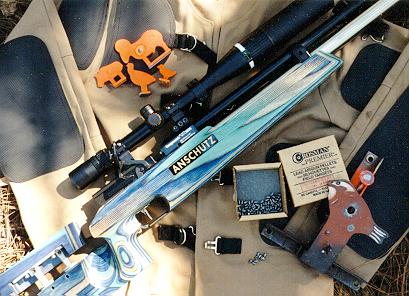
The Anschütz 2025 Air Rifle
By Brad Troyer
click the ad to visit this advertiser, View All Advertisers On This Page
For years there have been airgunners out there trying to build a "better mousetrap" in the target/match air rifle arena. Most of their efforts have been in the area of converting 10 meter style match air rifles for use in high power applications like Field Target and Silhouette. Some of these efforts were successful while others have had their share of problems.
In the meantime, the airgun community had been lobbying many of the 10 meter airgun manufacturers to design and build a line of higher velocity match rifles. For a long time, most of the prompting was met with an attitude of "there isn't a big enough market to make it profitable".
Things started to change as the popularity of Field Target began to increase both here in the United States and over in Europe. With the market for a high power match rifle starting to grow, many of the major air rifle companies started to take notice. Anschütz was one of those companies.
Anyone who has been involved with any type of competitive rifle shooting knows the name of Anschütz. They are one of the top gun manufacturers in the world producing match air rifles, match firearms and a line of high quality sporting arms. Their products are known for their high quality and suburb accuracy.
The crew at Anschütz started to develop a high power match rifle in 1989 and had the new 2020 and 2025 on display at the 1999 SHOT show. The two rifles are based on the 2002CA 10 meter rifle with some internal designs to accommodate the higher pressures required for 12-16 ft. lbs. energy output. The two guns are identical with the exception that the 2020 is limited to 12 ft. lbs. for the British market while the 2025 power was increased to around 16 ft. lbs. for the power hungry American market.
Starting with the 2002CA as a baseline, Anschütz redesigned the internals of this award winning match rifle for high power shooting. Some of the design changes included modifications to the regulator, springs changes and trigger component alterations. On the exterior, the guns look and feel basically the same with the exception of the air reservoir and sights. The new rifles are sold with no sights and the reservoir has been lengthened to be flush with the end of the barrel.
I had the opportunity to speak with Dieter Anschütz at the 1999 SHOT show about the new rifles and talked with him about getting a rifle to review once they went into production. Seven months later I received an email out of the blue from Dieter asking me if I still wanted a rifle for review. I said, "No, I don't want to shoot a new state of the art air rifle", yea right. I emailed him back immediately with an address where he could ship the rifle.
Two weeks later a brand spanking new 2025 was sitting on my back porch. It came in a wide short box which I thought was rather strange, knowing that the rifle was much longer than the box on my porch. Once the box was opened, I saw that the action was removed from the stock that explained the shorter box. I quickly assembled the rifle, looked over the instruction manual and removed the air reservoir. I took the filling adapter and reservoir over to my air tank to fill it up. It was then that I realized that the filling adapter was a DIN adapter and not an A-frame type adapter that I need to connect to my tank. I needed an A-frame to DIN adapter to be able to fill the reservoir, boy was I disappointed.
After unsuccessfully checking around my area for an adapter, I got a hold Scott Pilkington at Pilkington Competition Equipment and he sent me (at no charge) an adapter so that I could proceed with my testing. It goes to show that there are some nice guys in the airgun business.

In the meantime, I went about mounting one of my B&L Elite 4000 6-24x scopes on the 2025. The breech block is made up of two pieces bolted together with one of the scope rails on the front part of the breech and the other rail on the rear breech. The cocking arm is on the rear breech block and I had heard that when the rifle was cocked that the rear breech block may move 5-15 thousands of an inch which may not sound like much but it is enough to have an effect on accuracy. I decided to mount my scope in the traditional fashion with one mount on the rear breech behind the scope's turrets and one on the front breech in front of the turrets to see if any accuracy problems surfaced.
The scope rail offered plenty of room on both front and rear rails to place the mounts for good scope support. One thing I noted on the rear mount was that I had to be cognizant of the travel of the cocking arm as the rear mount may interfere with the cocking arm. I had to turn my Sportsmatch mount so that the mount bolts were on the side away from the cocking arm so that the bolt heads would hit the cocking arm.
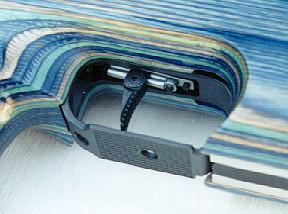
With the scope mounted I started to adjust the trigger unit. The 2025 comes with the standard Anschütz match trigger that is pretty much standard fare for all their match rifles. The trigger unit is adjustable for all typical adjustments including first stage weight, first stage travel, second stage weight, second stage travel (sear engagement), over travel, trigger angle and trigger cant. The adjustments were very easy to perform, however the action had to be removed from the stock. I initially set it up as a two stage trigger with a short first stage and no perceptible second stage travel but with heavier pull weight.
The 2025 doesn't have a specific dry fire mechanism like some other 10 meter rifles. If you want to practice by dry firing, the reservoir must be unscrewed a couple of turns so that the connection to the regulator is severed. This allows you to practice fire the rifle without discharging air. With the trigger setup finished I figured that it would be a good time to set up the stock too.

A blue color laminated 10 meter style stock is standard for the 2025 but an all metal aluminum stock is available for around $450. Underneath the entire length of the forearm runs an accessory rail and inside the rail is a black plastic insert that slides along the rail to give the bottom of the stock an even feel. With the insert moved up close to the trigger, the rifle can be rested comfortably on the arm, otherwise the accessory rail digs into the top of the arm.
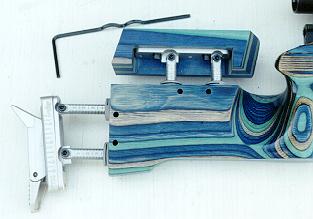
At the rear of the stock is the new aluminum adjustable butt plate that comes standard on most of the Anschütz match air rifles. The butt plate is almost infinitely adjustable being able to adjust up, down, left or right cant, pull length, plate angle and top hook angle. The butt plate is held in place by two grub screws in the end of the stock that are adjusted by a special Allen wrench provided with the rifle. The wrench is also used for making adjustment to the butt plate and cheek piece hardware.
As you might expect, the cheek piece has the typical adjustments including vertical, horizontal, angle and left/right cant. The test rifle was from the first production lot that didn't have the left/right cant adjustment, but a replacement is available if you happen on to one without it. The cheek piece comb is not rolled over like you might find on other Field Target rifles or sporter rifles, instead it is an hard angle that is prevalent on most 10 meter rifles. Without the cant adjustment, I found this type of cheek piece a bit uncomfortable. Perhaps this is personal preference but I found it made the gun a bit less comfortable to shoot than some other rifles I have tested. The cant adjustment makes the cheek piece much more comfortable to me.
The stock was not designed as a Field Target stock but with the adjustability of the cheek piece and butt plate, it can be made to fit the shooter pretty well. The stock has a short overall length of pull, even with the butt plate adjusted out to the maximum setting. This was no doubt due to the needs of 10 meter shooters who shoot standing for the most part. The only real complaint I have with the stock is that there isn't a vertical thumb rest like so many other Field Target match stocks. I find person ally that I shoot better with my thumb upright on the right side of the stock rather than wrapping it around the grip as is required with this stock.
After a few days passed, a small box appeared at my front door, it was the A-frame to DIN adapter! The DIN filling adapter was screwed into the A-frame adapter and the 2025's reservoir was ready to be removed and filled. Normally when the reservoir is removed, it is unscrewed one full revolution and the 2-3 shots are taken to remove existing air in the regulator. The reservoir can then be removed easily and without any problems.
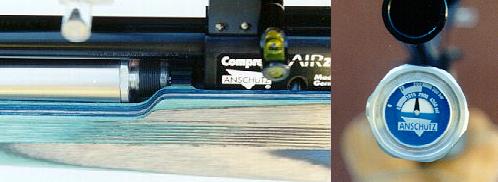
The air reservoir on the test rifle is made from stainless steel that makes it fairly heavy. I was told by Anschütz that a lighter reservoir is in development and should be available sometime in late 2000. Having attached the reservoir to the DIN filling adapter, the valve on the air tank was opened and the needle in the air pressure gauge that is attached to the end of the reservoir began to slowly move up to the recommended maximum 2900 psi mark. After closing the vale and bleeding the small amount of excess air, I reinstalled the reservoir by first cocking the rifle (don't forget this or you will vent a lot of air down the barrel) and simply screwing the reservoir back onto the rifle.
Now it was time to actually shoot the rifle for the first time. I cocked the rifle by firmly grabbing the cocking handle located on the right side of the action and pulling it up and rearward to set the trigger and open the loading port. The initial cocking effort was rather stout but after a few hundreds rounds the action broke in and the effort dropped to a very comfortable level.
After a few minutes of sighting in, the rifle was shot at some test target at 50 yards. The first groups were not really impressive, certainly not up to what I had expected. However the firing cycle was smooth and the report was moderate. The gun balanced well in the sitting position with it setting across my left arm. It was very easy to shoot from the standing position, which was no big surprise. I noticed a slight muzzle flip when the rifle was fired but little other movement.
The rifle's performance over the next few weeks was not impressive with groups averaging around 3/4" at 50 yards off the bench. That is good when compared to most other airguns but not what you would expect from an Anschütz rifle. I shot groups with both Crosman Premier 10.5 and Beeman Kodiak pellets but both produced approximately the same size groups.
After about three months and several hundred rounds through it I decided to readjust the trigger and the length of pull of the rifle. I lightened the trigger and set it to single stage while increasing the length of pull to approximately 14" which is about the same as several of my other rifles. Suddenly my groups shrank to 1/2"-5/8" shooting from position with several ragged hole groups where one flyer opened up the group. With the new adjustments I was able to hold the gun much steadier and more comfortably. The lighter setting on the trigger also helped my trigger control and follow through.
| Crosman Premiers 10.5 |
Beeman Kodiak Match |
|
|---|---|---|
| Average Accuracy | 0.73 | 0.65 |
| Smallest | 0.63 | 0.50 |
| Largest | 0.94 | 1.0 |
The groups from the bench had improved after several hundred rounds, but not much. The 2025 didn't seem to perform as well from the bench as it did when held and shot from a normal shooting position. It seemed to be rather hold sensitive on the bench and you had to really work to get the best groups out of it. The 2025 seemed to favor the Kodiak Match over the Premiers.
I noticed during several shooting sessions that the adjustable objective on my scope would move from the 50 yard setting down to 45 or 46 after shooting session. I also noticed that it would periodically throw a pellet outside what was a tight group without explanation. That makes me think that there may be a vibration or harmonic happening during the firing cycle that may be causing the poorer than normal bench groups. Another possible reason suggested to me is the fact that the barrel is under some tension when the breech is closed which may affect harmonics in the barrel. At any rate, the accuracy results sh ould be qualified by the fact that I saw improved groups off the bench.
| Crosman Premiers 10.5 |
Beeman Kodiak Match |
|
|---|---|---|
| Average Velocity | 822 | 835 |
| Standard Deviation | 3.02 | 1.82 |
| Highest | 826 | 838 |
| Lowest | 816 | 831 |
| Extreme Spread | 10.0 | 7.0 |
| Weight | 10.5 | 10.6 |
| Energy | 15.8 | 16.4 |
When the 2025 was first announced, it's advertised velocity was to be around the 800 fps mark. However the test rifle averaged around the 830 fps mark with Crosman Premier 10.5 pellets, yielding 16 ft. lbs. of energy. The overall velocity performance was good but the extreme spread was bigger than I had expected.
I have shot the rifle in several matches while evaluating it with good success with it. The first match I shot occurred a few weeks after receiving the 2025, I managed to win the match after a shoot-off at a 3/4" target at 34 yards. Even though I won the match I didn't feel the rifle was performing up to the standards of the other Field Target rifles. I used the 2025 in two matches a few months later on Superbowl weekend. By now the rifle had broken in and was shooting very accurately. I had more time wit h it and with the new adjustments, I was simply shooting it better.
I won my class at the Saturday match with it, again in a shoot-off at a 3/8" target at 20 yards. The rifle performed well all day and I really was getting comfortable with the single stage trigger. I didn't shoot well on the Sunday match but still manage to place second in my class. I can't fault the rifle as it was hitting where it was pointed, I just wasn't pointing it at the right spot!
In the process of shooting it over a 5 month period with a wide variety of temperature and humidity changes the point of impact changed twice, once when I readjusted the trigger and stock, the other was after it broke in. Since the rifle settled down, it has been stable and consistent.
It appears that Anschütz's first attempt at a high power match rifle has been successful, however the performance of the 2025 over the long haul still needs to be proven. Will it have regulator failures or start zero shifting as it ages? Only time will tell, but as for now, the 2025 is a rifle that performs well and has an attractive price tag. I would guess that this is only the beginning of a line of high performance match rifles from Anschütz that may set the standard for all high power match rifles in the future.

click the ad to visit this advertiser, View All Advertisers On This Page
Anschütz 2025 Specs
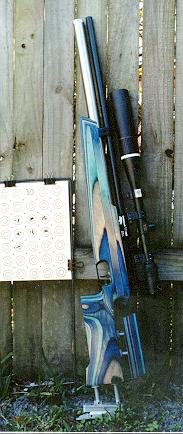
| Model | 2025 |
|---|---|
| Manufacturer | Anschütz, Germany |
| Type | Pre-charged Pneumatic |
| Caliber | .177 |
| Energy | 16 ft. lb. (variable) |
| Overall Length | 42.5" |
| Weight | 10.3 lbs. |
| Barrel | 16.5" |
| Sights | None |
| Stock | Laminated Match |
| Safety | Manual |
| Trigger | 2 stage match adjustable |
| Retail Price | $1400 |
Back to Review Page
Back to American Airgun Home
Top of Page

click the ad to visit this advertiser, View All Advertisers On This Page
© Copyright 2006 by Brad Troyer & American Airguns


